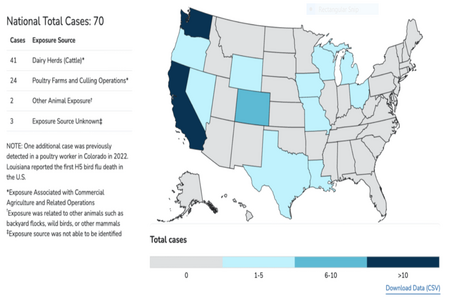by Ryan Hanrahan, University of Illinois’ FarmDoc project
Bloomberg’s Jessica Nix reported that “the US Centers for Disease Control and Prevention ended its emergency response for bird flu as the outbreak that sickened dozens of people, spread to cattle and drove up egg prices has abated. The emergency designation ended in the last week, according to a person familiar with the matter who wasn’t authorized to speak publicly about it.”
“The CDC merged its bird flu updates with those routinely reported for seasonal influenza starting on Monday, and will post the number of people monitored and tested for the virus also known as H5N1 on a monthly basis, the agency said,” Nix reported. “It will no longer include infection rates found among animals on its website.”
“States that were among the hardest hit have also dialed back their efforts. California ended its emergency declaration in April, a spokesperson for the Department of Public Health told Bloomberg,” Nix reported. “Washington, which had 11 human cases in 2024, is also downsizing its response, state epidemiologist Scott Lindquist said.”
“The CDC’s emergency bird flu response was deactivated to transition back to regular program activity, according to a spokesperson for the Department of Health and Human Services,” Nix reported. “Surveillance, readiness and response for bird flu will be included with existing efforts from the CDC’s Influenza Division and other agency programs, they said.”
CNN’s Brenda Goodman and Sarah Owermohle reported that “Dr. Nirav Shah, who resigned this year from his position as CDC principal deputy director, says he would have also chosen to end the emergency response.”
“‘This was not something that was imposed from the top down. It was initiated by the career scientists at CDC,’ said Shah, now a visiting professor at Colby College in Maine,” according to Goodman and Owermohle’s reporting. “‘The rationale is, in short, there haven’t been any human cases. And so there is not the need to sprint all-out every single day when there haven’t been human cases in a while. If there were to be more human cases, it is very easy to ratchet back up the level of the intensity of the response. It can literally be done in an afternoon.'”
Current Bird Flu Situation
In humans, the CDC reports that there are currently no know cases in the United States. Since the start of the current bird flu outbreak in 2022, there have been 70 total human cases in the US and one death.
In animals, according to the USDA’s Animal and Plant Health Inspection Service, there has been just one new confirmed case of bird flu in cattle in the last 30 days — in Arizona — and just two since the start of June. The last significant outbreak was in dairy milking cows in Idaho in May.
For commercial and backyard chicken flocks, there have been 3 new confirmed cases in the last 30 days, APHIS said. Those cases occurred in Arizona, Idaho and Pennsylvania and have affected about 30,000 birds. The latest significant outbreaks in poultry occurred in May, when several million birds were affected in Maricopa County, Arizona.
Some Experts Express Concern about Changes
Nix reported that “while the states said they’re still monitoring bird flu activity and will coordinate with federal officials, doctors and researchers said the moves will make it harder to detect potentially dangerous changes. If the virus continues to jump between species or the human case count grows, there’s a greater risk that it could mutate and become more easily transmissible between people, they said.”
“‘We are letting our guard down,’ said Michael Kinch, an infectious disease expert and chief innovation officer at Stony Brook University in New York,” Nix reported.
“…Reducing attention to the virus could leave a gap when it is still circulating in migratory birds in the US, health experts said,” Nix reported. “‘If you do miss an uptick, then you’ll be one step behind and then that could lead to more widespread transmission and more herds being infected, more people being infected,’ said Dean Blumberg, head of pediatric infectious disease at University of California, Davis.”





